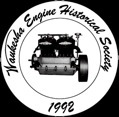The Motor Works - Part 8 (added September 2014)
Waukesha Motor becomes Waukesha Engine with sale to Dresser
 |
JOHN SCHOENKNECHT |
Company weathers economic challenges of ’70s and ’80s
Another huge change occurred in 1974. A group of Waukesha Motor Co. executives submitted an offer to buy the company from Bangor- Punta in March. The offer was $23 million for a company which had cost an estimated $35 million. Bangor- Punta did not have the capital to invest in the facilities Waukesha Motor needed.
But instead of accepting the executive’s offer, Bangor- Punta sold Waukesha Motor Co. to Dresser Industries of Dallas, Texas, in July. The company was renamed Waukesha Engine Division of Dresser Industries.
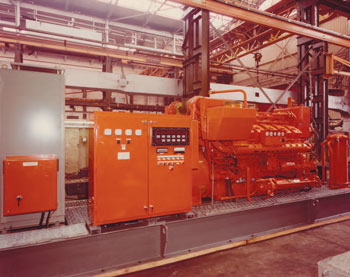 |
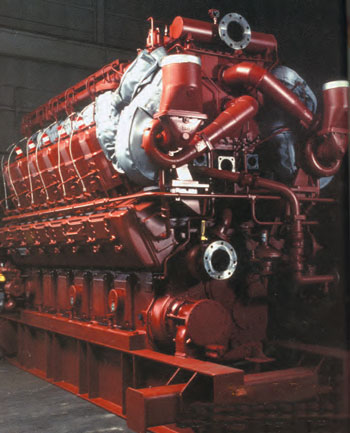 |
| Photo from the Waukesha Engine Historical Society | Photo from “Facing Forward” by Michael Goc |
| 1977 – One of four 750 kw 1200 rpm 60 Hz diesel generator sets supplied to Chevron Petroleum U.K. Ltd. to serve as the emergency services generators for the huge Ninian Central and Southern platforms in the British North Sea off the Shetland Islands. | A 1980s Model 12VAT25GL.This model was converted from diesel fuel to natural gas. It was an early example of Waukesha Dresser’s use of powerful, exclusively gas-fueled engines. |
Dresser was a leading supplier of high-technology products and services for energy and natural resource industries. In 1973 the firm had about 42,700 employees and sales totaling $1.25 billion. It had 50 plants, mines and mills in the United States and Canada.
Dresser was founded in 1880 as the S.R. Dresser Manufacturing Co. in Bradford, Pa. It was headquartered for a while in Cleveland and moved to Dallas in 1957.
 |
| Photo from “Facing Forward” by Michael Goc |
| The new Waukesha Dresser logo |
In 1975, Dresser Industries sales topped $2 billion. The energy processing and conversion segments, which included Waukesha Engine, accounted for almost onequarter of that. But despite the high sales, Waukesha Engine fell victim to the cycle of inflation that hit the country. In March 1975, most overtime work at the plant was discontinued and 25 workers were laid off. Most of them were new hires. The layoffs were partially blamed on a shortage of parts.
A fire on May 1, 1975, destroyed four storage sheds on the property. No one was hurt. The shed contained mostly packing crate lumber.
In October 1975, Waukesha Engine announced a major plant remodeling. It included a new high-rise warehouse, machinery wing, and modernization and improvement throughout the facility. The plan had five distinct phases. Work began in May 1976 when the engine testing complex, constructed during World War II, was demolished to make way for new facilities.
Layoffs
More workers were temporarily laid off in January 1976 as an expected influx of new orders did not happen as quickly as anticipated. By the end of October, 320 workers and 60 management workers were terminated. The slowdown continued. The plant was shut down for the weeks of Nov. 22 and 29. Seven hundred workers were laid off without pay.
In February 1977, Robert D’Armour resigned as president of the company. He was 53 years old at the time. During his term as president, the company doubled in size and entered the world market with six overseas sales and service offices. But the economic conditions of 1976 led to a large number of layoffs. D’Armour resigned for personal and health reasons.
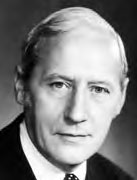 |
| Photo from the Waukesha Engine Historical Society |
| President Chester E. Lee. |
Chester E. Lee was then named executive vice president of Dresser Industries and president of Waukesha Engine. Lee was born and raised in London. After earning his engineering degree, he worked in various spots around the world. He had a short stint with Waukesha Motor in 1970-71. In the mid 1970s he worked for Chrysler, supervising the construction of a plant in Tehran, Iran. Lee moved back to the U.S. when Dresser asked him to become president.
In an effort to introduce himself and improve communications with the workers, Lee held a series of meetings at the Waukesha County Expo Center. His presidency brought a new sense of optimism to the company.
Lee supervised the completion of the renovation plan during the next few years. In 1979, as part of the modernization program, the assembly lines were realigned from the north-south axis used since 1909 to a more efficient east-west direction.
A new computerized parts system was introduced. As soon as a part was made, it was assigned a computer number and stored in the high-rise warehouse. When it was needed, a worker merely called for the part via the number. This system was extremely efficient compared to the hand counting that had been introduced 50 years previously. But by the mid-1990s, the new computer system was replaced by outsourcing to a different company.
A few other noteworthy improvements were the construction of 22 new test cell spaces, replacement of cranes, hoist and shipping and receiving equipment with modern machinery, sealing the assembly rooms to avoid dust and dirt, modernization of the paint room to meet new safety standards and upgrading the entire plant for more energy efficiency.
The final phase took place in 1981 when a new front entrance was constructed on St. Paul Avenue and the offices were remodeled.
The 1980s: Recession and recovery
The decade saw the company decrease the number and variety of engines it built. It also saw a great reduction in the number of people in its workforce. It concentrated on fewer models that were larger and more profitable. There was less need for huge space to assemble its product.
A great honor occurred in 1980 when the American Society of Mechanical Engineers designated the 1929 Waukesha Motor Co. CFR engine an international historical landmark. The original engine is displayed at the Waukesha Engine Historical Society.
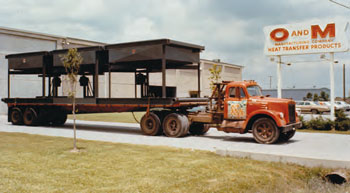 |
| Photo from the Waukesha Engine Historical Society |
| The O and M Manufacturing Company of Texas built radiators for Waukesha Engines. |
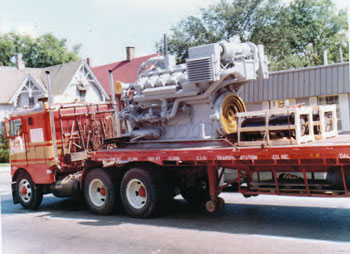 |
| Photo from the Waukesha County Museum |
| In the 1984 Sesquicentennial Parade, a model L5788GSI was displayed. |
In 1981, Waukesha Engine purchased a license from Sulzer Brothers Ltd. of Winterthur, Switzerland, to produce its family of diesel engines. The company needed to invest more to build the large engines, which were used in drilling rigs, electric generating plants, marine vessels and offshore rigs.
But as the optimism grew, the country fell into a recession that plagued President Reagan’s first year in office. Construction and agriculture were hard hit. When the oil industry experienced a fall in prices, thousands of drilling operations shut down.
According to Michael Goc: “On one day in 1982, Chet Lee walked into the sales department and found no orders booked. ‘Do you mean to say,’ he asked, ‘that with all our distributors, all our contacts, no one in the world wants to buy a Waukesha engine today?’ The answer he was forced to accept was, yes, no one wanted to buy a Waukesha Engine that day and on quite a few others. As a result, sales volume sank and by mid-1983, the number of employees on St. Paul Ave. fell below six hundred – lower than in any year since 1917, including the early 1930s. Employment numbers would rise again to peak at 1,200 in 1986, before falling below 1,000 by the mid-1990s and staying there.”
In November 1982, in the midst of recession, the company bought the vacant Grede Foundry that stood to the east of the plant on the corner of Prairie and St. Paul avenues. The plant was demolished and a new secure parking area and gateway sign were constructed.
As the world market supplied cheap, throw-away engines to the U.S., Waukesha Engine lost business in the construction and agricultural fields. At the same time, new international markets were opening up. Waukesha received an order for 25 CFR engines from China in 1983.
In 1984, Chester Lee resigned and Ben R. Stuart was named president. Stuart was a 25-year veteran of Dresser Industries domestic and international manufacturing operations. He told reporters that the days of Waukesha building diesel engines were numbered and that the future was in gas engines.
The following year, the ATGL series and the first Model GL lean-burn, lowemission gas engine was introduced.
In 1986, the company broke ground for a new Product Training Center on the Prairie Avenue side of its land. The building contains classrooms and a shop area with work stations that can be used for hands-on training. Employees from around the world are trained at the center.
Ben Stuart ended his shortlived presidency of the company when he received a promotion at Dresser.
Peter C. Trombley took over as president in 1987. He initiated efforts to ensure that there was quality at each step of the company’s operations. The drive to make gas engines continued when Trombley acquired the rights to build engines designed by the Spanish Gauscor Company.
Both the Gauscor and Sulzer engines were “Waukeshaized” (a term used by Michael Goc) to burn gas instead of diesel.
One of the advantages of buying the rights to these engines was the speed in which they could be put into production. If Waukesha engineers were to completely design and test a model from scratch, it could take seven to 10 years. By purchasing the rights, the company was able to manufacture and modify the engines quickly.
At the end of the decade, in 1989, Waukesha Engine closed its Clinton, Iowa, plant.
About the same time, Waukesha purchased the Brons Industrie in the Netherlands and began producing the VHP and VGF engines at its gas engine manufacturing plant in Appingedam.
(John Schoenknecht can be reached at thbolt@wi.rr.com.)
This article was originally published in the Thursday, February 20, 2014 issue of The Freeman Waukesha County's newspaper.
Copyright © 2014 Waukesha Engine Historical Society, Inc. All rights reserved
